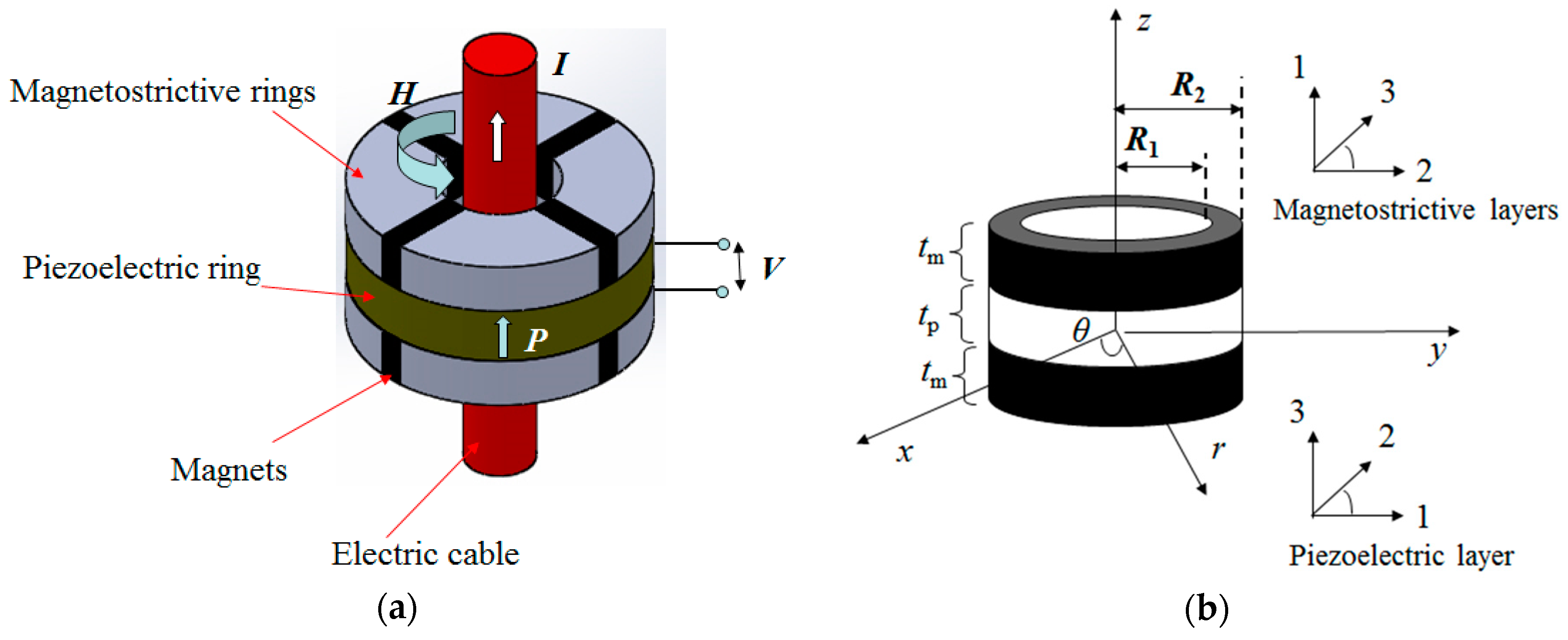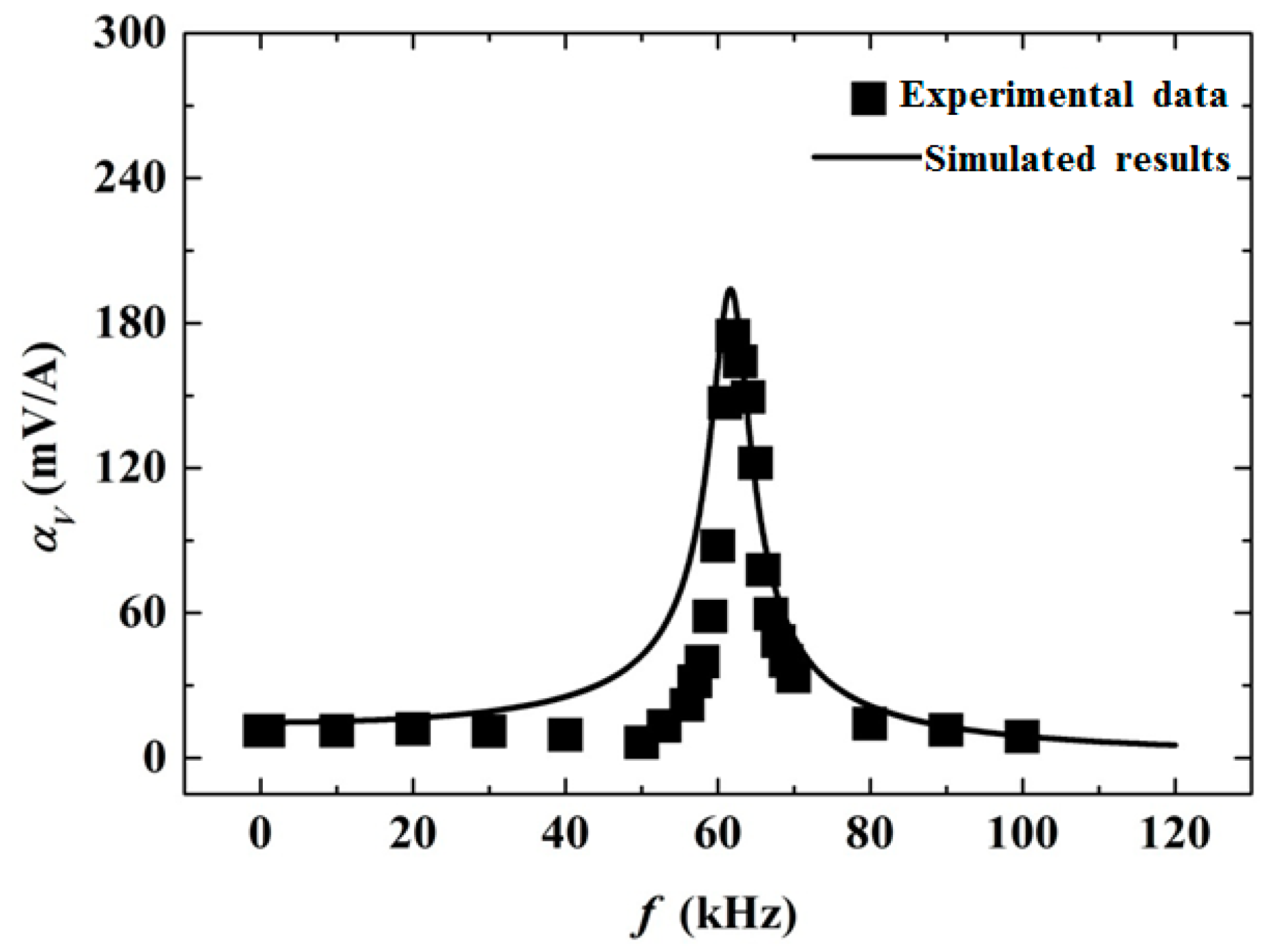Modeling of a Magnetoelectric Laminate Ring Using Generalized Hamilton’s Principle
Abstract
1. Introduction
2. Modeling of ME Laminate Ring by Conventional Method
3. Modeling of ME Laminate Ring by Generalized Hamilton’s Principle
4. Experimental Procedure
5. Results and Discussion
6. Conclusions
Author Contributions
Acknowledgments
Conflicts of Interest
References
- Ciomaga, C.E.; Neagu, A.M.; Pop, M.V.; Airimioaei, M.; Tascu, S.; Schileo, G.; Galass, C.; Mitoseriu, L. Ferroelectric and dielectric properties of ferrite-ferroelectric ceramic composites. J. Appl. Phys. 2013, 113, 1–7. [Google Scholar] [CrossRef]
- Ryu, J.; Carazo, A.V.; Uchino, K.; Kim, H.E. Magnetoelectric properties in piezoelectric and magnetostrictive laminate composites. J. Appl. Phys. 2001, 40, 4948–4951. [Google Scholar] [CrossRef]
- Ramos, P.; Amorin, H.; Ricote, J.; Castro, A.; Alguero, M. Insights into the performance of magnetoelectric ceramic layer composites. J. Compos. Sci. 2017, 1, 14. [Google Scholar] [CrossRef]
- Srinivasan, G. Magnetoelectric composites. Annu. Rev. Mater. Res. 2010, 40, 153–178. [Google Scholar] [CrossRef]
- Zhang, R.; Duan, Y.F.; Or, S.W.; Zhao, Y. Smart elasto-magneto-electric (EME) sensors for stress monitoring of steel cables: design theory and experimental validation. Sensors 2014, 14, 13644–13660. [Google Scholar] [CrossRef] [PubMed]
- Dong, S.; Li, J.F.; Viehland, D. Longitudinal and transverse magnetoelectric voltage coefficients of magnetostrictive/ piezoelectric laminate composite: experiments. IEEE Trans. Ultrason. Ferroelectr. Freq. Control 2004, 51, 794–799. [Google Scholar] [CrossRef]
- Fiebig, M. Topical review: revival of the magnetoelectric effect. J. Phys. D Appl. Phys. 2005, 38, R123–R152. [Google Scholar] [CrossRef]
- Lawes, G.; Srinivasan, G. Introduction to magnetoelectric coupling and multiferroic films. J. Phys. D Appl. Phys. 2011, 44, 243001. [Google Scholar] [CrossRef]
- Bichurin, M.I.; Filippov, D.A.; Petrov, V.M.; Laletsin, V.M.; Paddubnaya, N.; Srinivasan, G. Resonance magnetoelectric effects in layered magnetostrictive-piezoelectric composites. Phys. Rev. B 2003, 68, 132408. [Google Scholar] [CrossRef]
- Bichurin, M.; Petrov, V. Modeling of Magnetoelectric Effects in Composites; Springer Series in Materials Science: Berlin, Germany, 2014. [Google Scholar]
- Bichurin, M.I.; Petrov, V.M.; Srinivasan, G. Theory of low-frequency magnetoelectric coupling in magnetostrictive-piezoelectric bilayers. Phys. Rev. B 2003, 68, 1–13. [Google Scholar] [CrossRef]
- Filippov, D.A.; Bichurin, M.I.; Petrov, V.M.; Laletin, V.M.; Poddubnaya, N.N.; Srinivasan, G. Giant magnetoelectric effect in composite materials in the region of electromechanical resonance. Tech. Phys. Lett. 2004, 30, 6–8. [Google Scholar] [CrossRef]
- Dong, S.; Li, J.F.; Viehland, D. Longitudinal and transverse magnetoelectric voltage coefficients of magnetostrictive/ piezoelectric laminate composite: theory. IEEE Trans. Ultrason. Ferroelectr. Freq. Control 2003, 50, 1253–1261. [Google Scholar] [CrossRef]
- Chavez, A.; Lopez, M.; Youssef, G. Converse magneto-electric coefficient of concentric multiferroic composite ring. J. Appl. Phys. 2016, 119, 233905. [Google Scholar] [CrossRef]
- Wang, W.; Xu, X.; Zhou, L.; Luo, X.; Zhang, L. Tuning electromechanical resonances in strip-ring magnetoelectric composites structure with dc magnetic field. J. Appl. Phys. 2013, 114, 064101. [Google Scholar] [CrossRef]
- Wang, W.; Wu, J.; Luo, X.; Zhou, L.; Xu, X.; Ma, Q. Jump effect based magnetically tunable resonance of PZT-ring/TDF-strip composite with improved sensitivity. Sensor. Actuat. A-Phys. 2015, 225, 47–52. [Google Scholar] [CrossRef]
- Youssef, G.; Lopez, M.; Newacheck, S. On the effect of polarization direction on the converse magnetoelectric response of multiferroic composite rings. Smart Mater. Struct. 2017, 26, 037003. [Google Scholar] [CrossRef]
- Hagood, N.W.; Chung, W.H.; Flotow, A.V. Modelling of piezoelectric actuator dynamics for active structural control. J. Intell. Mater.Syst. Struct. 1990, 1, 327–354. [Google Scholar] [CrossRef]
- Ho, S.T. Electromechanical Analysis of a ring-type piezoelectric transformer. In Mechatronic Systems, Simulation, Modeling and Control; Milella, A., Paola, D.D., Cicirelli, G., Eds.; InTech: London, UK, 2010; pp. 1–16. [Google Scholar]
- Crandall, S.H. Dynamics of Mechanical and Electromechanical Systems; McGraw-Hill: New York, NY, USA, 1968; pp. 88–97. [Google Scholar]
- Claeyssen, F.; Lhermet, N.; Letty, R.L.; Bouchilloux, P. Actuators, transducers and motors based on giant magnetostrictive materials. J. Alloys Compd. 1997, 258, 617–673. [Google Scholar] [CrossRef]
- Zhang, S.; Zhang, R.; Jiang, J. Modeling the magnetoelectric effect in laminated composites using hamilton’s principle. Mater. Res. Express 2018, 5, 015705. [Google Scholar] [CrossRef]
- Piezo Kinetics, Inc. Technical Data Sheets. Available online: www.matweb.com/search/GetMatlsByManufacturer.aspx?navletter=P&manID=448&manname=Piezo+Kinetics%2C+Inc. (accessed on 9 March 2019).
- Or, S.W.; Carman, G.P. Dynamic magneoelastic properties of epoxy-bonded Terfenol-D particulate composite with a preferred [112] crystallographic orientation. IEEE Trans. Magn. 2005, 41, 2790–2792. [Google Scholar] [CrossRef]
- Or, S.W.; Li, T.; Chan, H.L.W. Dynamic magnetomechanical properties of Terfenol-D/epoxy pseudo 1-3 composites. J. Appl. Phys. 2005, 97, 10M308. [Google Scholar] [CrossRef]



© 2019 by the authors. Licensee MDPI, Basel, Switzerland. This article is an open access article distributed under the terms and conditions of the Creative Commons Attribution (CC BY) license (http://creativecommons.org/licenses/by/4.0/).
Share and Cite
Zhang, R.; Zhang, S.; Xu, Y.; Zhou, L.; Liu, F.; Xu, X. Modeling of a Magnetoelectric Laminate Ring Using Generalized Hamilton’s Principle. Materials 2019, 12, 1442. https://doi.org/10.3390/ma12091442
Zhang R, Zhang S, Xu Y, Zhou L, Liu F, Xu X. Modeling of a Magnetoelectric Laminate Ring Using Generalized Hamilton’s Principle. Materials. 2019; 12(9):1442. https://doi.org/10.3390/ma12091442
Chicago/Turabian StyleZhang, Ru, Shengyao Zhang, Yucheng Xu, Lianying Zhou, Futi Liu, and Xunqian Xu. 2019. "Modeling of a Magnetoelectric Laminate Ring Using Generalized Hamilton’s Principle" Materials 12, no. 9: 1442. https://doi.org/10.3390/ma12091442
APA StyleZhang, R., Zhang, S., Xu, Y., Zhou, L., Liu, F., & Xu, X. (2019). Modeling of a Magnetoelectric Laminate Ring Using Generalized Hamilton’s Principle. Materials, 12(9), 1442. https://doi.org/10.3390/ma12091442



